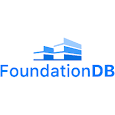Distributed Transactions in FoundationDB
FoundationDB is an open-source database that provides distributed ACID
transactions. In this post, we will see how FoundationDB uses optimistic and
multi-version concurrency control techniques to provide strictly serializable
distributed transactions.
 How can we be sure that a replica is up-to-date enough? Maybe there is a
more recent value with version less than t, but the replica has not received
it yet.
How can we be sure that a replica is up-to-date enough? Maybe there is a
more recent value with version less than t, but the replica has not received
it yet.
 Can we say the proxy basically runs a 2PC?
Can we say the proxy basically runs a 2PC?
 But we said the resolver keeps track of all versions committed in the last
5 seconds. How can a resolver do that without knowing if the transaction
finally committed or not?
But we said the resolver keeps track of all versions committed in the last
5 seconds. How can a resolver do that without knowing if the transaction
finally committed or not?
 As you said above, running a sort of incomplete 2PC between a proxy and
resolvers may abort transactions that should not be aborted in the future
which is not desired. What is the benefit of avoiding 2PC here?
As you said above, running a sort of incomplete 2PC between a proxy and
resolvers may abort transactions that should not be aborted in the future
which is not desired. What is the benefit of avoiding 2PC here?
 But then how can we handle replica failures? If one of the replicas
goes down, the system will be unavailable?
But then how can we handle replica failures? If one of the replicas
goes down, the system will be unavailable?
 So to get the read version for each transaction, the proxy has to talk to
other proxies? Isn't it a scalability issue?
So to get the read version for each transaction, the proxy has to talk to
other proxies? Isn't it a scalability issue?
 What is the purpose of using the maximum of all previously committed
timestamps as the read version?
What is the purpose of using the maximum of all previously committed
timestamps as the read version?
 But suppose proxy A asks proxy B its highest committed timestamp, but after
that and before proxy A return read version to the client, another commit
occurs on proxy B. Now the read version is not greater than all previously
committed transactions.
But suppose proxy A asks proxy B its highest committed timestamp, but after
that and before proxy A return read version to the client, another commit
occurs on proxy B. Now the read version is not greater than all previously
committed transactions.
 How linearizability is guaranteed when we have multiple Proxies?
How linearizability is guaranteed when we have multiple Proxies?
In other words, linearizability concerns about non-concurrent operations--operations whose request-to-return interval do not overlap with each other. If T1 starts while T2 has committed and returned to the client, there is no way that we can justify writes by T2 appearing to take place after T1. In that case, the system must make sure that the timestamp of T1 is greater than T2 which FoundaitonDB guarantees that.
 When we have multiple proxies, how does a transaction log computes
the KCV?
When we have multiple proxies, how does a transaction log computes
the KCV?
Now, let's see what happens to the storage servers with this transition of the transaction subsystem. Before the recovery, the storage servers were pulling writes from transaction logs and applying them. Thus, in the example above, a storage server may apply transaction 120 before the failure happens. This is not good, as according to the recovery version, the ownership of the subsystem has changed to the new master at time 110. Thus, any data with a version greater than the recovery version written by the previous generation of the transaction subsystem and applied by storage servers must be rolled back. Thus, in the example above, the storage server will rollback the mutations by transaction 120.
 What if a transaction T has read a version written by transaction 120 in
the example above before we rollback?
What if a transaction T has read a version written by transaction 120 in
the example above before we rollback?
 But what the client is supposed to do with this "result_unknown"? Suppose
this is an important transaction such as payment; the application must
know the payment was finally successful or not?
But what the client is supposed to do with this "result_unknown"? Suppose
this is an important transaction such as payment; the application must
know the payment was finally successful or not?
Before we start, I suggest that you study the official resources by
FoundationDB that I have cited at the end. This post is complementary to those
resources and tries to answer questions that might arise reading them.
Architecture
Figure 1 shows the overall architecture of FoundationDB. We can categorize
components into stateful and stateless components.

|
| Figure 1. The architecture of FoundationDB [1]. The blue boxes are stateful and the green boxes are stateless components. |
Stateful Components:
-
Coordinators: The job of coordinators is to elect a cluster
controller by running a consensus algorithm. The first version of
FoundationDB used Zookeeper but later it changed.
-
Transaction Logs: The transaction logs form a distributed
Write-Ahead Log (WAL). Each transaction log is replicated for higher
availability. In this post, we don't consider a sharded transaction log.
Thus, we consider the case where we have only one transaction log that it
is replicated.
- Storage Servers: Each storage server is an individual key-value store hosting a part of the data. Each storage server is replicated. Storage servers directly serve the read requests. Each storage server is tied to only one of the replicas of the transaction log and pulls updates from it.
Stateless Components
- Cluster Controller: Cluster control is picked by the coordinators. All components register themselves to the cluster controller.
-
Master: The job of the master is assigning commit timestamps to the
transactions. There is only one instance of the master. The master is picked
by the cluster controller.
-
Resolvers: Resolvers are used to perform conflict checking on
transaction and vote to commit/abort transactions. Resolvers together
maintain a cache of all versions written in the past 5 seconds. The
resolvers are sharded by the key range, i.e. each resolver maintains the
versions written for a particular range of the keys.
- Proxies: As the name suggests, proxies are the agent of the client to communicate with the rest of the system. A proxy gets commit timestamp from the Master, performs conflict checking via resolvers, and appends committed transactions to the transaction logs.
Read Path
As said above, reads are directly served by the storage servers. Thus, when a
client wants to read a version, it directly asks the storage server hosting
the key. If the client does not know which server it has to go to, it asks one
of the proxies. Before a transaction can read, it first gets a read version from the database. We will explain below how this version is assigned
to the transaction. All reads in the context of a transaction use this read
version. A storage server maintains a version chain for each key that it
hosts. When a client wants to read a key at a particular read
version t, the server returns the most recent value with a version
less than or equal to t.
This is very similar to snapshot timestamp in Spanner as we saw in
this post. In Spanner, we have t_safe to make sure a replica is updated enough and has
all values with versions less than t_safe. Most likely FoundationDB is using a
similar approach.
Write Path
Writes are simply buffered on the client. FoundationDB uses the optimistic
concurrency control. Thus, there is no 2PL and no lock is acquired for the
items that a transaction touches. At the commit time, the client submits its
read and write sets to one of the proxies. The read set includes all keys read
in the context of the transaction together with their versions, and the write
set is the set of key-value pairs written in the context of the transaction.
Once the proxy got the commit request from the client, it asks the master to
assign a commit timestamp to the transaction. The master is the only singleton
in the system. However, it never becomes a scalability bottleneck for two
reasons:
- Its job is very simple, i.e., just assigning commit timestamp to the transactions.
- If there are lots of transactions waiting for the commit timestamp, the proxy batches them all and sends a single request to the master.
After getting the commit timestamp, the proxy asks the resolvers to decide
whether it should commit the transaction or not. Each resolver checks the
read-set of the transaction. If the resolver finds out that there is a value
committed with a version greater than the version of the value read by the
transaction, it votes to abort the transaction. The proxy gets all the
responses from the resolvers. If all of them of said Yes, the proxy decides to
commit the transaction. Otherwise, it aborts the transaction.
It is not 2PC, as we don't have 2 phases. Once the proxy gets the responses
from the resolvers it does not sends the second phase of 2PC to let them know
about the decision.
When a resolver votes Yes to a transaction, it assumes the transaction will
commit, so it goes ahead and updates its cache. Indeed, it might not be the
case and the transaction may abort due to a No from another resolver. However,
assuming an aborted transaction as committed by a resolver does not violate
the correctness. It only might abort future transactions due to this false
belief. Aborting a transaction can never violate the correctness of
serializability. However, it might be bad from the performance point of
view.
Note that anything we put to the cache of a resolver will last only for 5
seconds. After 5 seconds, it seems as if we didn't add it in the first place.
In that short time, if we really want to avoid any false abortion, we have to
implement a locking mechanism on the resolvers to keep future inflight
transactions pending until we learn the final decision for an earlier
transaction. This locking comes with its overhead and FoundationDB avoids
that. FoundationDB's philosophy, like other optimistic systems, is to provide
high performance for low contention workloads.
After the proxy decides to commit a transaction, it appends the write set of
the transaction to the transaction logs. Note that, for a single transaction,
the proxy might need to talk to several transaction logs, as the transaction
logs may be sharded. However, in this post, assume we always have only one
shard for the transaction log and it is replicated for higher availability.
The FoundationDB does not use consensus algorithms such as Paxos or Raft for
replicating the transaction logs. Instead, it simply requires to synchronously
write to ALL replicas of a transaction log.
In the case of a replica failure, FoundationDB starts a new replica to keep
the number of healthy replicas to the desired replication factor. We will
talk about fault-tolerance later in this post.
Note that like all WALs, the data on transaction logs must be durable. Thus, a
transaction logs fsync the data to the disk before returning
to the proxy. After the proxy appended the updates to the transaction logs, it
returns success to the client. Later, the storage servers pull mutations from
the transaction logs and apply them.
Get Read Version
As we said above, a client gets a read version from FoundationDB for each
transaction and includes it in every read request it sends to storage servers.
The storage servers then make sure not to return any version with a timestamp
higher than the read version. Now let's see how FoundationDB provides this
read version.
To get the read version, the client asks one of the proxies. The proxy, asks
other proxies the highest commit timestamp they have assigned to a
transaction. The proxy then returns the maximum timestamp it received from
other proxies and its own highest commit timestamp and returns it to the
client.
Like getting the commit timestamp from the master, here also we can solve the
scalability issue by batching the transactions. So the proxy can batch many
read version requests, ask other proxies and calculate the max timestamp, and
send it to all clients as the read version. All of them will receive the same
read version.
As we explained in
this post, to guarantee strict serializability, we need to make sure that when T1
starts after T2 commits, T1 can see the effect of T1. Since FoundationDB does
not make values with timestamps greater than the transaction read version
visible, we need to make sure the read version is greater than the commit
timestamp assigned to any previously committed transaction.
The read version has to be larger than all committed versions before the transaction starts. The new commit to proxy B that you described above
occurs after the original transaction started. Thus, the read version can be
smaller than the new committed version on proxy B.
Strict Serializability
FoundationDB guarantees the strict serializability by the following
invariants:
- The writes of transactions are separated by their commit versions and no two transactions have the same commit version.
- All reads of a transaction happen at a single point in time determined by the read version. Thus, newer versions are ignored, and a transaction is guaranteed to read the most recent versions committed before the given time.
- Commit timestamps are monotonically increasing.
- Both the read and commit timestamps of a transaction T are guaranteed to be greater than the commit timestamp of any transaction committed before T starts.
Invariants 1 and 2 guarantee the isolation part of the strict
serializability. Invariants 3 and 4 guarantee the
linearizability part.
Consider this example: Suppose, we have two proxies P1 and P2. We have
two transactions T1 and T2 both writing the same key. T1 goes to P1 and T2
goes to P2. P1 gets commit timestamp 1 from the master, and P2 gets
timestamp 2 from the master. Since P1 is slow, P2 goes ahead and commits its
transaction with timestamp 2. Then, P1 commits its transaction.
Now, we have this: T1 has committed next, but its timestamp is less than
that of T2, i.e. commit timestamps do not respect the real-time order. Now,
if we read the value of the key, we read the value return by the T2,
although T1 is the last transaction that is committed. Doesn't it violate
linearizability?
There is nothing wrong with the scenario above. Note that linearizability
requires the writes to appear at a single point in time between the start and
the end of the operation. Thus, we are allowed to put that point anywhere
between the time the client sends its request and the time system returns the
result. Thus, in this example, although T1 commits next, a linearizable system
is allowed to put the actual point in time when T1 writes its mutation before
that of T2. This situation happens because T1 and T2 are
actually concurrent transactions, and a linearizable system
is allowed to order them anyway it likes.
In other words, linearizability concerns about non-concurrent operations--operations whose request-to-return interval do not overlap with each other. If T1 starts while T2 has committed and returned to the client, there is no way that we can justify writes by T2 appearing to take place after T1. In that case, the system must make sure that the timestamp of T1 is greater than T2 which FoundaitonDB guarantees that.
Fault-tolerance
Each storage server is replicated. Thus, when a storage server dies, the
client can go to the other replicas of that shard to read. Thus, handling
the crash of a storage server is straightforward. In this section, we focus
on the crash and recovery for components in the transaction subsystem. The
transaction subsystem includes the following components: master, proxies,
resolvers, and transaction logs. The master continuously checks the health
of proxies, resolvers, and transaction logs. If any of them crashes, the
master terminates itself. Once the cluster controller finds out that the
master is crashed/terminated, it picks a new master. The new master recruits
a new instance for every component in the transaction subsystem and
starts the recovery process. Note that a single failure in any
component in the transaction subsystem causes all other components in the
transaction subsystem to be replaced with new processes. Also, the failure
of the cluster controller itself will cause the coordinators to pick a new
cluster controller and start the recovery process. Thus, FoundationDB uses a
unified recovery process for a failure in any of these components. Now,
let's see what is this recovery process.
Recovery Process
The new master replaces all components in the transaction subsystem with new
instances. Thus, we will have new proxies, new resolvers, and new transaction
logs. During the recovery, the system does not accept new requests. Before
resuming the traffic, the new master first figures out at what timestamp it
must consider itself taking the ownership and claiming as the new master. This
timestamp is called the recovery version. The requirement for the
recovery version is
not to be less than the timestamp of any previously committed
transaction. Let's see how the master finds the recovery version.
The new master first asks the coordinators where are the previous transaction
logs. It then asks each transaction log the following information:
- Known Committed Version (KCV): KCV is the highest version that a proxy has appended to all replicas of the transaction log. For example, when KCV is 100, we know that any transaction with a commit timestamp less than or equal to 100 is appended to all replicas of the transaction log. A transaction log learns this value periodically from the proxies.
- Durable Version (DV): It is the maximum timestamp that is appended to a transaction log.
This is not covered in FoundationDB official documents, but logically, I
think the transaction log should use the minimum of KCVs that it
received from all proxies as its own KCV, because as we said, a
transaction log must be certain that the mutations with versions less
than the KCV are appended to all replicas of a transaction log.
Upon a request from the master for KCV and DV, the transaction log locks
itself, so it won't accept any new transaction. After getting responses from
transaction logs, the master picks the minimum of all returned DVs as its
recovery version. Let's see why: As we said earlier, FoundationDB requires
the quorum size N for appending to transaction logs (where N is the
transaction log replication factor). Thus, all replicas must be aware of the
latest committed transaction. Thus, by taking the minimum of the DVs, we can
be sure that the selected timestamp is not less than the timestamp of any
previously committed transaction. Any future timestamp given by the master
will have a value greater than the chosen recovery version. Figure 3 shows
an example. The transaction log 1 is crashed and is not responding. The
master receives 110 and 120 from the remaining replicas and takes 110 as the
recovery version.
Now, let's see what happens to the storage servers with this transition of the transaction subsystem. Before the recovery, the storage servers were pulling writes from transaction logs and applying them. Thus, in the example above, a storage server may apply transaction 120 before the failure happens. This is not good, as according to the recovery version, the ownership of the subsystem has changed to the new master at time 110. Thus, any data with a version greater than the recovery version written by the previous generation of the transaction subsystem and applied by storage servers must be rolled back. Thus, in the example above, the storage server will rollback the mutations by transaction 120.
To read a version written by transaction 120, transaction T must have received
a read version greater than or equal to120. A transaction cannot commit unless
the proxy has appended its mutation to all of the transaction logs. Thus, if T
managed to get a read version >= 120, then all DVs must be at least 120
which is not the case. Thus, there could not be such a transaction.
After finding out the recovery version, the new transaction system is ready to
accept new transactions, but before that, FoundationDB artificially increases
the time by 90 seconds causing all inflight transactions to abort due to
"transaction too old" error [3]. Note that even read-only transactions require
to commit before returning to the clients. Thus, inflight read-only
transactions will also abort. The storage servers continue reading from the
old transaction logs. After pulling all mutations of an old transaction log, a
storage server switches to the new transaction logs.
There are cases where due to a failure, FoundationDB returns
result_unknown for transactions that are in the final stage of
committing, i.e. appending to transaction logs. In Figure 3, a proxy appended
transaction 100 to all three replicas but suppose the proxy crashes before
returning success to the client. In this example, transaction 100 will be
applied to the storage servers as the recovery version is 110. Now, consider
the same situation for transaction 120; suppose a proxy appends 120 to
transaction log 3 and then crashes. Unlike transaction 100, transaction 120
will aborts. From the client-side, these situations are the same--the proxy
crashes before returning the result, but one transaction will commit and apply
on storage servers, and the other will abort and rollback. In this situation
(and other cases like this) the client will receive result_unknown.
The client has to retry its transaction. To satisfy the application-level
consistency (e.g. to avoid redundant payments), the application developers
have to make sure their transactions are idempotent, i.e., applying the same
transaction more than one time has the same effect as applying it one time.
One way is to assign each transaction a Global Transaction Identifier (GTID)
and deduplicate mutations with the same GTID. Note that even though
FoundationDB may return result_unknow for some transactions, that does not
mean it relaxes on providing ACID guarantees for those transactions. In other
words, although the clients do not know the result, those transactions will
still be either atomically applied or discarded, and if committed, they
respect strict serializability.
In Figure 3, transaction logs 1 and 2 return 90 and 95 as their KCVs. Retuning
95 by transaction log 2 means all transactions with timestamps less than or
equal to 95 are appended to all replicas. However, for transactions 96 up to
110, we don't have information to know if they are appended to transaction log
1 or not, because the transaction log is crashed and is not responding. For
transactions in the range of [0-95] we know we have 3 (required replication
factor) copies. All future transactions will be appended to all 3 new
transaction logs, so will have 3 copies of them. However, for transactions
[96-110], we are not sure if have the required number of copies which is 3 in
this example. To make sure that we satisfy the required replication factor,
the master copies all transactions in the range of [max(KCVs)+1, recovery
version] to the new transaction logs. In this example, it copies [06-110] to
the new transactions logs. This way, we are sure that for all transactions we
have at least 3 copies in our transaction logs.
In summary,
- FoundationDB uses MVCC to provide isolated snapshots to read, and by making sure the snapshot time is always greater than the timestamp of any previously committed version it guarantees linearizability.
- To replicate transaction logs, FoundationDB does not use Paxos or Raft. Instead, it requires a quorum size equal to the replication factor. In the case of replica failure, it creates a new replica to have the required quorum size.
- All failures of the transaction subsystem are handled uniformly by a single recovery process.
References
[1] Evan Tschannen, "Technical Overview of FoundationDB", https://www.youtube.com/watch?v=EMwhsGsxfPU&feature=youtu.be
[2] "Technical Overview of the Database", https://github.com/apple/foundationdb/wiki/Technical-Overview-of-the-Database
[3] "FDB Recovery Internals", https://github.com/apple/foundationdb/blob/master/design/recovery-internals.md








Comments
Q2:In the paper,2.4.4,"the Sequencer knows the previous epoch has committed transactions up to the maximum of all KCVs"。why maximum?
Post a Comment